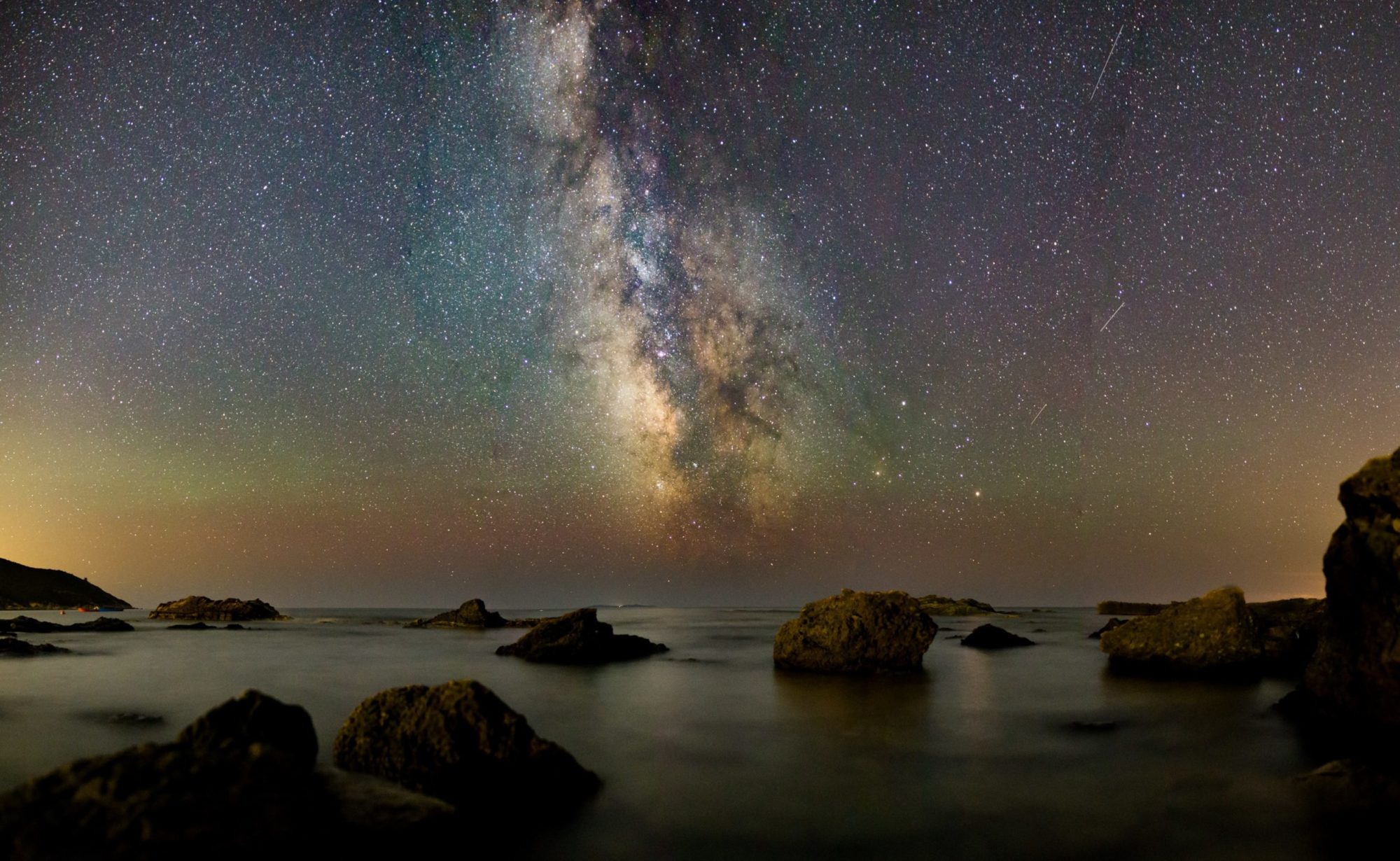BLUF: The militarization of space isn’t new. It dates back to WWII — and Reagan was pretty into it, too. But the 2019 announcement of a new military branch, Space Force, kicked off a new national debate. At the end of the day, experts across the political spectrum agree that the threats and competition in space are real. Despite disagreement on whether Space Force is the best solution, it’s a solution that is here to stay.
Last year, Netflix dropped a much anticipated (read: by only national security and military nerds), star studded comedy series about America’s newest branch of the military: Space Force. With Michael Scott and Phoebe Buffay headlining a story about what has largely been seen by the public as an absurdity, the jokes basically wrote themselves. But in all seriousness, what the hell is space force? And more importantly, does America really need it?
Space Force (also known as USSF) was established December 20, 2019 with enactment of the Fiscal Year 2020 National Defense Authorization Act. As the sixth branch of the US military, Space Force was established within the Department of the Air Force. Its mission? “Organize, train, and equip space forces in order to protect US and allied interests in space and to provide space capabilities to the joint force.”
STAR WARS: NATIONAL SECURITY AND SPACE
But the idea that space would eventually become a warfighting domain (like land, sea, and air) isn’t new. A 2020 Cato report notes that “the militarization of space began in the final years of World War II, when Germany began to strike England with V-2 ballistic missiles.” In fact, following the war, both America and the Soviet Union started to develop their own space programs leading to what was later known as the “space race.” Then came the “Star Wars program” launched under President Reagan back in 1983. The Strategic Defense Initiative (SDI) was a missile defense system some initially hoped might render nuclear weapons obsolete, given that Reagan wasn’t a fan of the nuclear deterrence theory known as mutually assured destruction. To further develop this concept of missile defense, in addition to lasers and particle beam weapons, the Strategic Defense Initiative Organization (SDIO) was born in 1984.
The SDI wasn’t Reagan’s only move in space. In 1985, he established a US Space Command as part of the Air Force where it lived until it was merged with the US Strategic Command in 2002 following 9/11. US Space Command was recently restarted, more on that later.
Fun fact: As the SDI political support lost steam when the Cold War came to a close and the program ultimately died in 1993, the Clinton Administration redirected funds toward efforts to theatre ballistic missiles and the agency was renamed the Ballistic Missile Defense Organization (BMDO), and later the Missile Defense Agency (MDA).
In the years following the STRATCOM merge, some military branches (Air Force, Navy and Army) each had its own focus on space. In fact, “A significant portion of US military activities tied to space has resided in the Air Force Space Command, headquartered in Colorado, with over 30,000 people worldwide and launch facilities in Florida and California.” But with the creation of the Space Force, it was announced in October 2020, that the first of three Space Force field command centers would be the Space Operations Command at Colorado’s Peterson Air Force Base. Then, under the Biden Administration, the Space Force announced on April 8, its plan to launch a Space Systems Command in Los Angeles. The Command will, among other things, be in charge of coordinating space programs across the US military. (Hint: you may start to see patterns emerge of military recycling of bases, commands, ideas, etc. for Space Force.)
SPACE JAM: A SIDE NOTE ON SPACE
While the most common perception of a threat in space may be deliberate sabotage or conflict, one of the most overlooked and dangerous parts of space is purely accidental. Enter space debris. Every time a country launches a satellite, loses a toothbrush from the space station, or launches a car for shits and giggles, space becomes a bit more congested. “Right now, there are nearly 6,000 satellites circling our tiny planet. About 60% of those are defunct satellites — space junk — and roughly 40% are operational.” It has been estimated that more than 2,500 operational satellites are chillin’ in space these days — SpaceX alone is responsible for more than half of those operational sats.
And maybe you think, “Interesting but who cares!” Well, frankly, YOU should care. Because you know what’s in space that we fundamentally depend on? Purposely launched and usable satellites.
These manmade bits are now flying around next to billions of particles of other space matter (think asteroid bits). And every time one of those pieces of debris collides with another piece of debris from a meteor shower, it creates a bunch of other tiny sharp particles that travel at exceptional speeds. “Each of those hundreds of thousands of pieces travel in excess of 4 miles per second. At such velocities, even a tiny fleck of paint can damage a spacecraft.” And maybe you think, “Interesting but who cares!” Well, frankly, YOU should care. Because you know what’s in space that we fundamentally depend on? Purposely launched and usable satellites.
For example: Your car’s GPS, television service, etc. — all of these things are linked to satellites in space. And it doesn’t take much of a space jam fender bender to render those bad boys useless. To remediate this issue and regulate the space environment, some provisions in international law exist, like the 1967 Outer Space Treaty. Under the treaty, countries are responsible for their defunct satellites and debris but, like most international law, international space law provisions and treaties have little to no binding effect (or ramifications for accidental or purposeful collisions).
So while cleaning up space junk is not exactly the reason the Space Force was created, it reminds us that — just like the land, sea, and air — space offers a valuable home to vital resources and competition.
You see, the world has come to depend on all these little floating satellites. It isn’t just about ensuring you can navigate your summer road trip; bank transactions, hospital internet, assessing climate change — none of it is possible without 24/7 satellite function. Which means that 1) the more satellites a country launches into space, the more congested orbits become thus the more likely accidents are to occur, and 2) as technology becomes more powerful and the more the globe depends on these satellites, the more tempting it may be to intentionally harm one as a means of warfighting.
As one article put it, “Space right now is a bit like the Wild West, with a wide-ranging mix of government and commercial satellites, all of them sitting ducks.” This concern was the stated rationale of the Trump administration, which argued that space was already being used as “war-fighting domain” by global powers (and competitors) like Russia and China. Not exactly a shocker since history has shown that where there is competition, militarization often follows.
Case in point: In 2007, China deliberately shot down one of its own satellites to prove it could. This is known as the 2007 Chinese Anti-Satellite Test. The action was seen by some as a global warning of its power, basically to say, “FYI: we can render your security systems, military’s GPS, hospital internet, etc. useless in a moment… if we want to.” To make matters worse, the aftermath littered space with 3,037 pieces of satellite shrapnel, adding to that space junk traffic jam.
GALACTIC CAMOUFLAGE: DO WE REALLY NEED A 6TH BRANCH?
As mentioned earlier, the idea of space militarization isn’t new. Some might even argue (raises hand) that the space race, coupled with Reagan’s “Star Wars,” foreshadowed something like “Space Force” was inevitable. And many national security experts on both sides of the aisle think, yeah, something like the Space Force is probably a good idea in theory (some think it may even have been too little too late). In 2019, both the House and Senate explored versions of a space military branch in their National Defense Authorization Acts (or NDAA) but disagreed on its structure, with the Senate backing the Force and the House looking at a “Space Corps.”
The biggest supporters of the Space Force argue that our adversaries are taking swift measures to compete in space and have already turned it into a warfighting domain. As they see it, the US is already behind and Space Force allows the US to 1) put concentrated efforts into one specific force; 2) improve readiness and spacepower, and 3) recruit and retain specific talent (think space, cyber, intel experts) for the branch as opposed to assigning Air Force members without expertise, and promoting accordingly those who do.
- John W. Raymond, Chief of Space Operations: “Our adversaries are moving deliberately and quickly in order to reduce our advantage [in space]… I’m not confident that we can achieve victory, or even compete, in a modern conflict without space power.”
- Gen. David Thompson, U.S. Air Force: “Not nearly enough people innately understand what we already have in space in a military sense,” referring to GPS and internet satellites. “For the nation, for national security, for our forces and perhaps ultimately for civil and economic benefits, we now have to be prepared to do that [operate in space] in the face of threats.”
Prominent policy think tanks were mixed in their reception of the branch with the Heritage Foundation supporting its creation; Center for Strategic and International Studies (CSIS) split on the subject, and the Project on Government Oversight and Cato Institute opposed.
However; there have been plenty of subject matter experts and prominent politicians who share criticism of the branch, calling for a different solution despite agreeing that space is or will be a contested arena. Many argue that creating a Space Force will take away the necessary integration of space matters from other military branches and agencies, creating a negative siloed effect. Others think a similar goal of competing with our adversaries in space could be achieved internally within a military branch, along with utilizing Space Command more heavily, without standing up an entirely new branch — which is an incredibly expensive endeavor, as you might imagine.
As Kaitlyn Johnson details in her opposition to the Force, “Deputy Secretary of Defense Patrick Shanahan even noted that standing up the new Service could cost ‘billions,’ though DoD has not completed a formal cost evaluation as of yet.” Shanahan further noted that “Some things are fairly certain to cost DoD: overhead costs, development of doctrine, consolidation of facilities, movement of people and families, a service academy or war college, recruiting pipelines, and of course, new uniforms.” Air Force Secretary Heather Wilson also told reporters in 2018 that “her initial $13 billion cost estimate to stand up a Space Force and sustain it for five years is likely to be revised upward as more data is crunched,” noting those numbers are conservative. At a time when the national debt is in the trillions and rising as America faces a pandemic bill, economic rescue, healthcare evaluations, student debt crisis, climate change costs, and still wants everything in the DoD treasure chest, you gotta start to ask — is this expense truly necessary?
- James Inhofe (R-Okla.) in 2018: “I’m opposed to [creating a sixth branch]… I know the president has strong feelings. I think we can do that without a new branch.”
- Harlan Ullman, chair of the Killowen Group: “The president proposed a 6th service, a space service, which is not only a bad idea but it would be unworkable… It would confuse, complicate and confound the situation already in the Pentagon. How would you actually organize it? Would you rip out different capabilities from the National Reconnaissance Office? From NASA? Getting this thing done bureaucratically would be a nightmare.”
Others point out that regardless of whether it’s the best solution or not, it would be a waste to stop now.
- Brian Weeden, director of program planning for the Secure World Foundation and a former space operations officer for the Air Force: “At this point we have spent thousands of hours and years of effort to create this new bureaucracy in the hope that it will address these challenges. At this point, we have no choice but to see that through. To now go back and spend even more time undoing all this stuff would be worse.”
In addition to those thousands of hours and years spent debating how our country was going to tackle the threats in space, we are also talking billions of dollars already spent over the past two years. The omnibus signed by Trump in December 2020 included $15.2 billion for the US Space Force in Fiscal Year 2021. Before the omnibus, the Air Force was transferring money to the Space Force to get it going which, I can only assume, was a lot harder than using Venmo. The jury remains out on what Space Force’s budget numbers will look like under Biden as the current administration has said it is here to stay. “We look forward to the continuing work of Space Force.”
REBRAND ME UP, SCOTTY!
In the end, some of the biggest issues with Space Force have been with its roll-out. And as any good PR expert will tell you (or your mom before your first interview) you usually only get one shot to make a good impression. So, if you want to be taken seriously, you can’t act like a joke. Because while the threats were real, announcing a new branch of the military in an off-hand, unprepared throwaway was a sure way to garner fast criticism. Instead of taking the time to explain the long-term rationale behind something like the Space Force to the general public, a logo campaign was launched and merchandise sold. To be taken seriously, as any military branch should be, it’s time to go back to the drawing board and lay the public groundwork. Since the Space Force appears here to stay, THE BABES BLUF might start with a roadshop media campaign to explain the threat and need to the public, strategically utilize social media (seriously), and drop the “cool dad” act.
That’s all for this one, babes.
No pressure. No bullshit. Just THE BABES BLUF.
THE BABES BLUF (bottom line up front) is a different kind of current affairs and lifestyle blog that talks about issues in a way women (and men!) can relate to and enjoy. To read more from THE BABES BLUF, visit www.thebabesbluf.com and subscribe to never miss a #BLUF, and check them out on Twitter or Instagram @thebabesbluf. For more THE BABES BLUF pieces, see here.





















